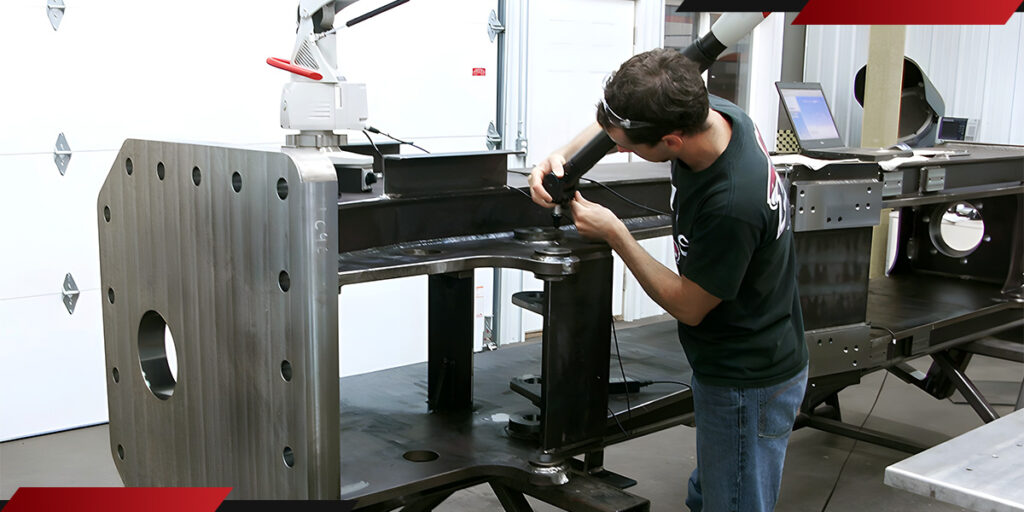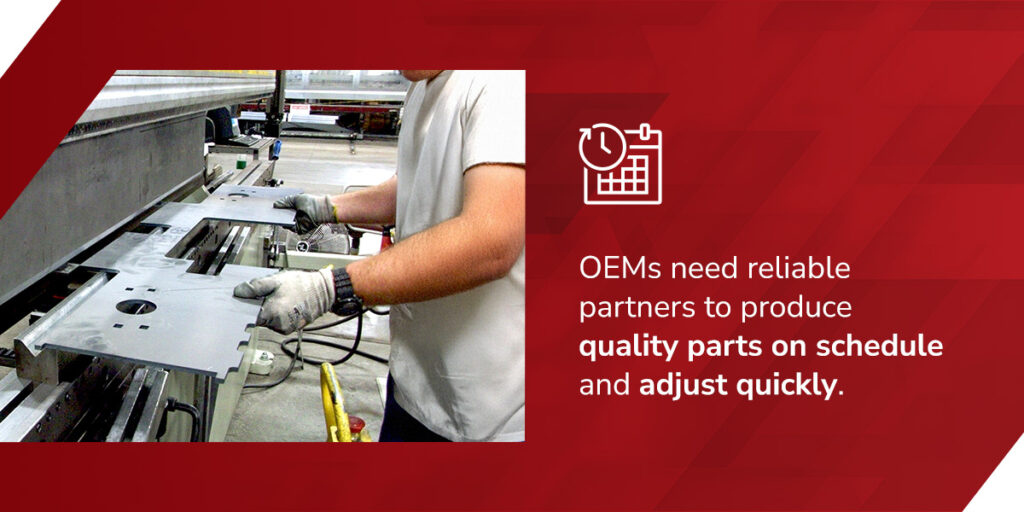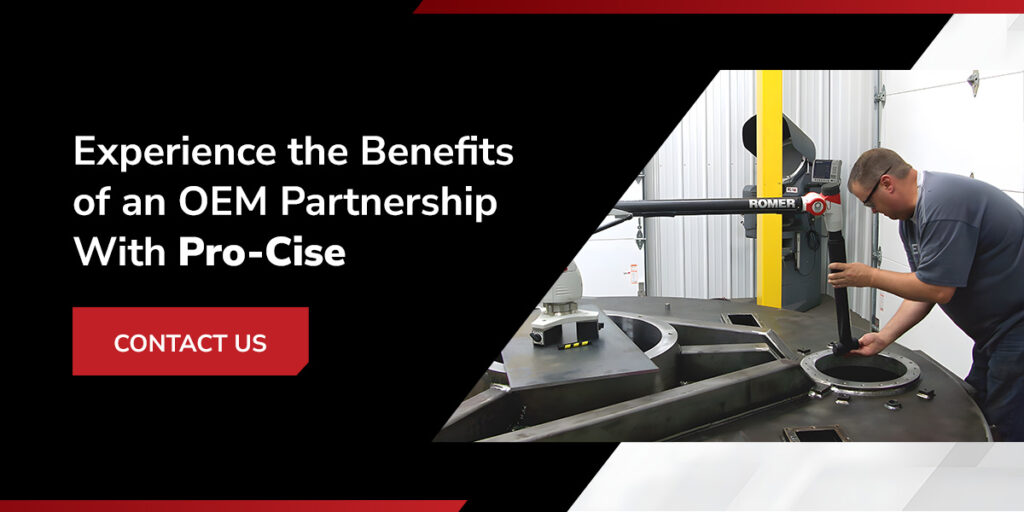
Original equipment manufacturers (OEMs) face intense pressure to deliver high-quality parts, meet production schedules and respond to changing customer demands. Many OEMs now rely on fabrication partners to address these challenges.
An OEM partner can improve output reliability and reduce delays. Factory and plant managers can use OEM alliances to extend their capabilities without investing in additional infrastructure. Let’s look at the four main OEM partner benefits and how they can transform your manufacturing process.
What Are OEM Partners?
An OEM partnership is a relationship between an OEM and an external supplier that provides or fabricates components used in the OEM’s assembly process. In-house production of every part can slow manufacturing. OEMs can rely on partnerships to manufacture complex components without supporting everything on their own.
In this structure, the OEM provides specifications, quality standards and materials to the supplier. Then, the supplier manages production. They source, fabricate and ship components to the OEM. It’s an efficient relationship for OEMs that commonly see manufacturing demands that exceed in-house capabilities. Sourcing specialized materials or creating odd-shaped components takes time away from your existing line. Having a partner means OEMs get needed components without changing in-house processes.
OEM alliances are unique to each business. Your operation will create short-run or long-term production agreements with your chosen partner. Fabrication suppliers may support assembly-level manufacturing or stand-alone components as needed. Each OEM will tailor partnerships to their industry demands.
Top 4 OEM Partnership Advantages
OEM partnerships can lead to many unique benefits that help support and grow your business.
1. Cost Optimization
Cost optimization is critical in manufacturing. Customers expect low prices and high quality, while OEMs need to maintain profits and grow. Finding a balance is essential for improving quality and delivery without compromising success.
Downtime costs manufacturers up to $50 billion annually. A reliable partner can help reduce costs by improving efficiency and reducing workloads.
Reducing Total Cost of Ownership (TCO)
OEM alliances manage costs by reducing components’ TCO. Suppliers use lean manufacturing principles to cut waste and optimize production. Additionally, investing in in-house specialization or expanded manufacturing is expensive — using a supplier with existing infrastructure lowers component costs.
Leveraging Turnkey Manufacturing Solutions
Suppliers with full-service manufacturing also eliminate the cost of working with multiple vendors. Coordinating machines, welding and surface treatments increases communication, ordering paperwork and expenses. A turnkey partner manages all aspects of fabrication while supporting complex orders. Eliminating multiple vendors cuts time-related costs like delays and reduces shipping and coordination expenses.
2. Quality Assurance and Risk Mitigation
Rush orders and unfamiliar processes may compromise your end product, leading to bottlenecks and damaging customer relationships. A qualified partner maintains high standards and throughput thanks to their industry experience. Outsourcing can prevent costly mistakes and compliance concerns.
Consistent Product Quality
Fabrication partners have the equipment and experience to meet tight tolerances and detailed print instructions. Reputable businesses will have quality assurance systems built around standards like ISO 9001 to ensure consistency. Parts need inspecting to confirm dimensional accuracy and finish quality before they arrive at your facility.
Consistency matters. Reworking or rejecting parts mid-production creates delays and budget overruns. A provider that prioritizes quality gives you reliable products.
Risk Mitigation Strategies
Partnerships can also act as buffers against supply chain risks. Choose suppliers with a diverse vendor base. This strategy improves sourcing stability and traceability, and you’ll see fewer disruptions when materials are hard to obtain.
Additionally, having an experienced supplier reduces the severity of issues when they occur. Experienced businesses can handle complex drawing and machine challenges. They’ll minimize production delays or tolerance problems that can lead to missed shipments and failed inspections.
3. Accelerating Time-to-Market and Lead Time Reduction

When production delays occur, OEMs may experience missed revenue and lost customers. OEMs need reliable partners to produce quality parts on schedule and adjust quickly. A responsive production ally keeps lead times short and manufacturing on track.
Integrated Supply Chain Solutions
A partner offering integrated supply chain solutions goes beyond making parts. They manage upstream and downstream logistics to keep production moving. A closed-loop system improves control over timelines, inventory and costs.
A fully integrated approach also strengthens supply chain continuity. Diverse vendors mean avoiding delays due to shortages. A provider that oversees everything from material sourcing to delivery can adjust to your needs without shutting assembly down. OEMs get an experienced partner who can operate efficiently and absorb challenges.
Streamlined Production and Delivery
Even minor delays can throw off production when OEMs are connected to reactive or isolated vendors. A responsive partner works with OEMs to adapt to demand or engineering changes. If you need to ramp up output or update a drawing mid-project, these companies provide answers quickly.
Additionally, their experience means production and delivery work faster than in-house, from-scratch work. They handle all aspects of fabrication startup and provide efficient delivery so your team can focus on what matters.
4. Design Collaboration for Innovation and Process Improvement
OEM partnership advantages aren’t limited to efficiency and cost-cutting. They even help your operation make smarter design decisions easily. Involving providers upfront means you get direct insight into potential risks and improvements. Use this early input to avoid expensive mistakes and slow production.
Collaborative Engineering
Early supplier involvement gives OEMs a critical advantage during the design phase. Experienced providers will review complex prints and offer insights into areas like weld sequencing, material sourcing and output capabilities. This approach reduces the risk of mid-production design changes or surprise costs.
Continuous Improvement
The best OEM partnerships are built around continuous improvement. Supplier-OEM relationships can use feedback, quality reviews and shared output data to identify improvement opportunities. Suppliers can adjust production or suggest better sourcing to streamline operations. Their experience and vendor access support better productivity and reliability over time.
Experience the Benefits of an OEM Partnership With Pro-Cise
When OEMs work with a trusted fabrication partner, they gain more than additional capacity — they get a resource committed to quality, reliability and long-term success.
At Pro-Cise, we specialize in producing engineered components that integrate seamlessly with your assembly-level manufacturing processes. We can handle it all, from sourcing unique materials to managing medium- to large-scale production runs. Pro-Cise helps operations reduce risk, shorten lead times and maintain high quality standards with every part we fabricate.
If your team is looking for an ally who can handle complex prints and deliver consistent results on schedule, Pro-Cise is ready to help. Our wide range of in-house capabilities includes complete process control. We’re a trustworthy partner for OEMs across industries. Reach out to see how we can support your next project!


